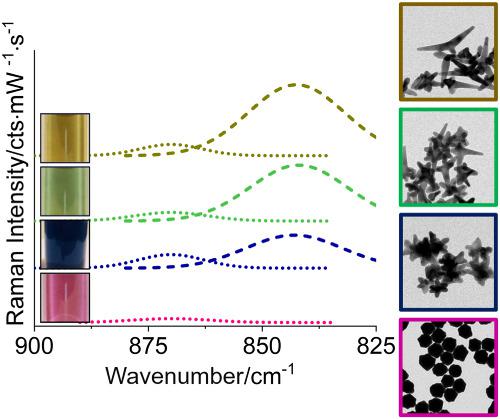当前位置:
X-MOL 学术
›
J. Raman Spectrosc.
›
论文详情
Our official English website, www.x-mol.net, welcomes your
feedback! (Note: you will need to create a separate account there.)
Tuning gold nanostar morphology for the SERS detection of uranyl
Journal of Raman Spectroscopy ( IF 2.4 ) Pub Date : 2020-09-21 , DOI: 10.1002/jrs.5994 Rachel A Harder 1 , Lahiru A Wijenayaka 1, 2 , Hoa T Phan 1 , Amanda J Haes 1
Journal of Raman Spectroscopy ( IF 2.4 ) Pub Date : 2020-09-21 , DOI: 10.1002/jrs.5994 Rachel A Harder 1 , Lahiru A Wijenayaka 1, 2 , Hoa T Phan 1 , Amanda J Haes 1
Affiliation

|
The impact of tunable morphologies and plasmonic properties of gold nanostars is evaluated for the surface‐enhanced Raman scattering (SERS) detection of uranyl. To do so, gold nanostars are synthesized with varying concentrations of the Good's buffer reagent, 2‐[4‐(2‐hydroxyethyl)‐1‐piperazinyl]propanesulfonic acid (EPPS). EPPS plays three roles including as a reducing agent for nanostar nucleation and growth, as a nanostar‐stabilizing agent for solution phase stability, and as a coordinating ligand for the capture of uranyl. The resulting nanostructures exhibit localized surface plasmon resonance (LSPR) spectra that contain two visible and one near‐infrared plasmonic modes. All three optical features arise from synergistic coupling between the nanostar core and branches. The tunability of these optical resonances is correlated with nanostar morphology through careful transmission electron microscopy (TEM) analysis. As the EPPS concentration used during synthesis increases, both the length and aspect ratio of the branches increase. This causes the two lower energy extinction features to grow in magnitude and become ideal for the SERS detection of uranyl. Finally, uranyl binds to the gold nanostar surface directly and via sulfonate coordination. Changes in the uranyl signal are directly correlated to the plasmonic properties associated with the nanostar branches. Overall, this work highlights the synergistic importance of nanostar morphology and plasmonic properties for the SERS detection of small molecules.
中文翻译:

调整金纳米星形貌以进行铀酰的 SERS 检测
评估金纳米星的可调形态和等离子体特性对铀酰表面增强拉曼散射(SERS)检测的影响。为此,使用不同浓度的 Good's 缓冲试剂 2-[4-(2-羟乙基)-1-哌嗪基]丙磺酸 (EPPS) 合成金纳米星。EPPS 发挥三种作用,包括作为纳米星成核和生长的还原剂、作为溶液相稳定性的纳米星稳定剂以及作为捕获铀酰的配位配体。由此产生的纳米结构表现出局域表面等离子体共振(LSPR)光谱,其中包含两种可见光和一种近红外等离子体模式。所有三个光学特征都源于纳米星核心和分支之间的协同耦合。通过仔细的透射电子显微镜(TEM)分析,这些光学共振的可调性与纳米星形态相关。随着合成过程中使用的 EPPS 浓度增加,分支的长度和纵横比都增加。这导致两个较低能量消光特征的数量级增加,并成为铀酰 SERS 检测的理想选择。最后,铀酰通过磺酸盐配位直接结合到金纳米星表面。铀酰信号的变化与纳米星分支相关的等离子体特性直接相关。总体而言,这项工作强调了纳米星形态和等离子体特性对于小分子 SERS 检测的协同重要性。
更新日期:2020-09-21
中文翻译:

调整金纳米星形貌以进行铀酰的 SERS 检测
评估金纳米星的可调形态和等离子体特性对铀酰表面增强拉曼散射(SERS)检测的影响。为此,使用不同浓度的 Good's 缓冲试剂 2-[4-(2-羟乙基)-1-哌嗪基]丙磺酸 (EPPS) 合成金纳米星。EPPS 发挥三种作用,包括作为纳米星成核和生长的还原剂、作为溶液相稳定性的纳米星稳定剂以及作为捕获铀酰的配位配体。由此产生的纳米结构表现出局域表面等离子体共振(LSPR)光谱,其中包含两种可见光和一种近红外等离子体模式。所有三个光学特征都源于纳米星核心和分支之间的协同耦合。通过仔细的透射电子显微镜(TEM)分析,这些光学共振的可调性与纳米星形态相关。随着合成过程中使用的 EPPS 浓度增加,分支的长度和纵横比都增加。这导致两个较低能量消光特征的数量级增加,并成为铀酰 SERS 检测的理想选择。最后,铀酰通过磺酸盐配位直接结合到金纳米星表面。铀酰信号的变化与纳米星分支相关的等离子体特性直接相关。总体而言,这项工作强调了纳米星形态和等离子体特性对于小分子 SERS 检测的协同重要性。











































 京公网安备 11010802027423号
京公网安备 11010802027423号